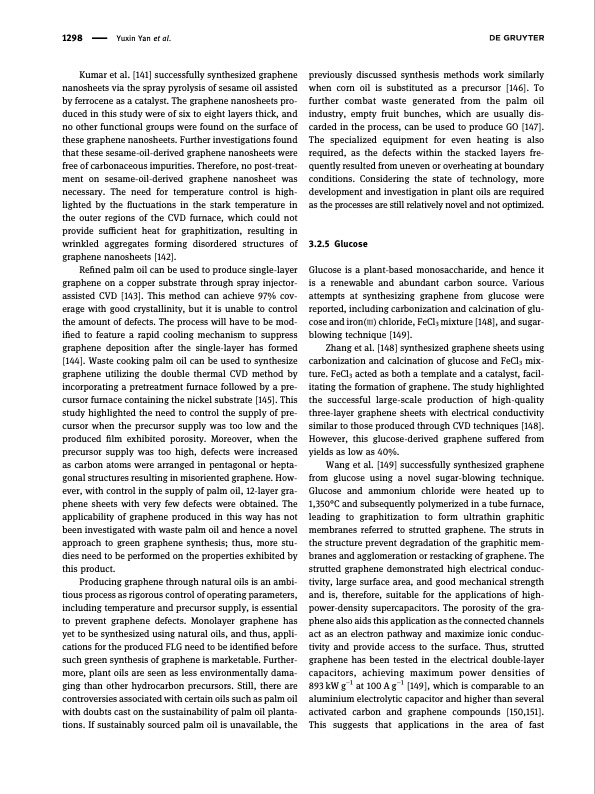
PDF Publication Title:
Text from PDF Page: 015
1298 Yuxin Yan et al. Kumar et al. [141] successfully synthesized graphene nanosheets via the spray pyrolysis of sesame oil assisted by ferrocene as a catalyst. The graphene nanosheets pro- duced in this study were of six to eight layers thick, and no other functional groups were found on the surface of these graphene nanosheets. Further investigations found that these sesame-oil-derived graphene nanosheets were free of carbonaceous impurities. Therefore, no post-treat- ment on sesame-oil-derived graphene nanosheet was necessary. The need for temperature control is high- lighted by the fluctuations in the stark temperature in the outer regions of the CVD furnace, which could not provide sufficient heat for graphitization, resulting in wrinkled aggregates forming disordered structures of graphene nanosheets [142]. Refined palm oil can be used to produce single-layer graphene on a copper substrate through spray injector- assisted CVD [143]. This method can achieve 97% cov- erage with good crystallinity, but it is unable to control the amount of defects. The process will have to be mod- ified to feature a rapid cooling mechanism to suppress graphene deposition after the single-layer has formed [144]. Waste cooking palm oil can be used to synthesize graphene utilizing the double thermal CVD method by incorporating a pretreatment furnace followed by a pre- cursor furnace containing the nickel substrate [145]. This study highlighted the need to control the supply of pre- cursor when the precursor supply was too low and the produced film exhibited porosity. Moreover, when the precursor supply was too high, defects were increased as carbon atoms were arranged in pentagonal or hepta- gonal structures resulting in misoriented graphene. How- ever, with control in the supply of palm oil, 12-layer gra- phene sheets with very few defects were obtained. The applicability of graphene produced in this way has not been investigated with waste palm oil and hence a novel approach to green graphene synthesis; thus, more stu- dies need to be performed on the properties exhibited by this product. Producing graphene through natural oils is an ambi- tious process as rigorous control of operating parameters, including temperature and precursor supply, is essential to prevent graphene defects. Monolayer graphene has yet to be synthesized using natural oils, and thus, appli- cations for the produced FLG need to be identified before such green synthesis of graphene is marketable. Further- more, plant oils are seen as less environmentally dama- ging than other hydrocarbon precursors. Still, there are controversies associated with certain oils such as palm oil with doubts cast on the sustainability of palm oil planta- tions. If sustainably sourced palm oil is unavailable, the previously discussed synthesis methods work similarly when corn oil is substituted as a precursor [146]. To further combat waste generated from the palm oil industry, empty fruit bunches, which are usually dis- carded in the process, can be used to produce GO [147]. The specialized equipment for even heating is also required, as the defects within the stacked layers fre- quently resulted from uneven or overheating at boundary conditions. Considering the state of technology, more development and investigation in plant oils are required as the processes are still relatively novel and not optimized. 3.2.5 Glucose Glucose is a plant-based monosaccharide, and hence it is a renewable and abundant carbon source. Various attempts at synthesizing graphene from glucose were reported, including carbonization and calcination of glu- cose and iron(III) chloride, FeCl3 mixture [148], and sugar- blowing technique [149]. Zhang et al. [148] synthesized graphene sheets using carbonization and calcination of glucose and FeCl3 mix- ture. FeCl3 acted as both a template and a catalyst, facil- itating the formation of graphene. The study highlighted the successful large-scale production of high-quality three-layer graphene sheets with electrical conductivity similar to those produced through CVD techniques [148]. However, this glucose-derived graphene suffered from yields as low as 40%. Wang et al. [149] successfully synthesized graphene from glucose using a novel sugar-blowing technique. Glucose and ammonium chloride were heated up to 1,350°C and subsequently polymerized in a tube furnace, leading to graphitization to form ultrathin graphitic membranes referred to strutted graphene. The struts in the structure prevent degradation of the graphitic mem- branes and agglomeration or restacking of graphene. The strutted graphene demonstrated high electrical conduc- tivity, large surface area, and good mechanical strength and is, therefore, suitable for the applications of high- power-density supercapacitors. The porosity of the gra- phene also aids this application as the connected channels act as an electron pathway and maximize ionic conduc- tivity and provide access to the surface. Thus, strutted graphene has been tested in the electrical double-layer capacitors, achieving maximum power densities of 893 kW g−1 at 100 A g−1 [149], which is comparable to an aluminium electrolytic capacitor and higher than several activated carbon and graphene compounds [150,151]. This suggests that applications in the area of fastPDF Image | Synthesis of graphene Potential carbon precursors

PDF Search Title:
Synthesis of graphene Potential carbon precursorsOriginal File Name Searched:
10-1515-ntrev-2020-0100.pdfDIY PDF Search: Google It | Yahoo | Bing
Salgenx Redox Flow Battery Technology: Power up your energy storage game with Salgenx Salt Water Battery. With its advanced technology, the flow battery provides reliable, scalable, and sustainable energy storage for utility-scale projects. Upgrade to a Salgenx flow battery today and take control of your energy future.
| CONTACT TEL: 608-238-6001 Email: greg@infinityturbine.com | RSS | AMP |